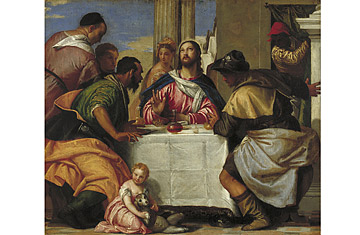
Supper at Emmaus by Paolo Veronese, part of the Boston Museum of Fine Arts' "Rivals in Renaissance Venice" show
(2 of 2)
The ease of working in oil also invited painters to experiment with rapid, summary brushwork, often to produce passages of sketchy, indeterminate form. This was the technique that Tintoretto above all made his own. Thirty years younger than Titian, the son of a dyer — hence the name — Tintoretto was the only one of the Big Three born in Venice. He very briefly apprenticed with Titian but was driven out of the workshop, according to some sources, because Titian was jealous of Tintoretto's evident gifts. For whatever reason there was bad blood between them ever after, and there ensued many instances when one sought to block the other from getting work or to use a highly visible public commission to outdo the other's effort.
By 1548, when the 60-year-old Titian was one of the best-known painters in Europe, the 30-year-old Tintoretto staked his claim to dominance with Miracle of the Slave, a tour de force crowd scene (not included in the Boston show) that he shrewdly unveiled while Titian was away from Venice so that the old man couldn't mobilize local opinion against it. With Tintoretto, the harmony and serenity of Bellini are entirely a thing of the past. Figures whirl, somersault and lunge like darts in and out of the picture. The palette is iridescent, and at close range, the sketchy forms can dissolve into a tangle of near illegible, stutter-step brushstrokes. Tintoretto's portraits were more restrained — aristocratic clients expected to be offered to the world as paragons of poise. But any religious or mythological scene, he could turn into a costumed mosh pit.
Veronese, 10 years younger than Tintoretto, was in his teens when he arrived in Venice from Verona — hence the name — and quickly became the third point in a triangular test of wills. Unlike Tintoretto, who struggled to find his mature style, Veronese shot out of the box as a boy genius — but a shrewdly humble one. Let Tintoretto play the role of Titian's perennial antagonist. Veronese would be the admiring pupil. Titian returned the favor by promoting Veronese whenever he could, especially for commissions that Tintoretto might be after.
The Boston show is full of groupings that allow you to compare how all three artists handled similar subjects. At various times, each of them produced a rendition of the Supper at Emmaus, the story from the New Testament in which the risen Christ reveals himself to a pair of astonished disciples. Titian's came first, in 1533-34, a picture of masterly calm and balance that borrows the stabilizing horizontal format of Leonardo's Last Supper. In 1542 the young Tintoretto took on the same subject and made it a scrum, full of lunging bodies and energies exploding outward to the edges of the canvas. It fell to Veronese in the mid-1570s to reconcile the two approaches. His Supper has more gestural drama than Titian's — arms are flung outward; one apostle's jaw drops. But because most of the figures are turned inward toward Christ, the picture has the coherence and structural integrity that Tintoretto's lacks.
Despite, or maybe because of, their constant competition, Titian and Tintoretto often found their artistic practices converging. Over the years, Titian's brushwork became much freer and more open — more like Tintoretto's. Meanwhile, much of Tintoretto's output as a portraitist is like a grudging homage to Titian, who had arrived in his own portraits at a balance of gravity and offhandedness, dignity and intimacy so perfect (and appealing to clients) that the younger man knew he had no alternative but to imitate it.
The last painting in the Boston show is a very somber self-portrait by the 70-year-old Tintoretto. It was painted around 1588, a dozen years after Titian's death and close to the time of Veronese's (he was abruptly claimed by pneumonia at age 60). The graybeard artist with sunken eyes stares out at us from a deep pool of shadow. He's the last man standing, indisputably now the greatest living artist in Venice. The great game is over — and he looks like he misses it.
